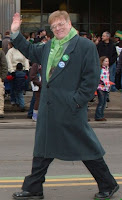Alex White and Dave Atias attended the City's first Voice of the Citizen meeting. This one was held at the Frederick Douglass Resource Center. The VOC's are focusing on violence. Alex and Dave were very appreciative of the voices heard in the packed house, especially the young adults from Teen Empowerment. The City seemed to focus on police-centered solutions while others, including Alex and Dave focused on jobs, recreation, financial literacy, restorative justice and more. There are three more, we hope to see you at one.
You can listen to the podcast here or click the link in the column on the right.
Transforming Rochester 18 - Voice of the Citizen 1
Tuesday, December 11, 2012
Labels:
Cool Down Detail,
David Atias,
job creation,
proactive policing,
racial profiling,
reducing crime,
restorative justice,
violence,
Voice of the Citizen
Posted by
Dave A
at
7:25 PM
0
comments
![]()
![]()
How To Reduce Crime
To do this, Rochester would be divided into 5 districts: Northeast, Southeast, Center City, Northwest, and Southwest. We would then have manageable neighborhoods designated for officers to patrol. For example, in the southwest district, there would be one officer in each of the following areas: Corn Hill, Mayors Heights, Genesee-Jefferson, and Bulls Head. Two officers would be in Plymouth Exchange and Lincoln Park and three in the 19th Ward. Each section of the city could easily be divided to provide neighborhood coverage. These officers would be supported by eight cars each with one officer in them and two cars with two officers.
The neighborhood officers would be encouraged to get out of their car and interact with the public, know the neighborhood, write tickets, and develop connections. The road patrols would respond to calls for service and assist neighborhood officers when arrests are needed. This division would allow officers to maximize their presence and provide better coverage to neighborhoods. With three officers for each neighborhood each day their hours could be arranged to maximize coverage during high crime times. As the downtown area is smaller than the rest of the areas, fewer officers would be needed and this would allow for a reserve of officers for special assignments, assistance with problem areas, and coverage of vacancies.
An important part of embedding police into neighborhoods is shifting to techniques such as community policing. This model of police activity is predicated on the belief that achieving safety goals requires the Police to develop a new relationship with citizens. Citizens would have the power to set local police priorities and therefore be involved in efforts to improve the overall quality of life in their community. Community Policing (CP) shifts the focus of police work from handling random crime calls to addressing community concerns. Police would still answer 911 calls and make arrests, but they also act as catalysts, involving people in efforts to police themselves. This is actually a recommended policing strategy of the US department of Justice.
This is just one step though, as in order to prevent crime we need a different tool and one of the most powerful is Restorative Justice. Restorative Justice (RJ) is a philosophy that believes in the power and influence of individual communities to work together toward improving the lives of everyone living in that community. In practice, RJ is collaboration between the perpetrator, the perpetrator's family, local neighbors, the DA, the police, and local government. The mechanism is a community meeting in lieu of a trial where the victim is part of the process and their needs are taken into account.
One of the assumptions here is that the accused is taking responsibility for their crime without a legal defense and will work to make restitution for their crime. This practice has been used in several cities throughout the world with amazing results. It has reduced crime, cured chronic problems like youth violence, and saved money. With a crime rate higher than NYC and rising rates for many violent crimes it is time to realize that we need a different approach. In NYC, “stop and frisk” has neither reduced crime nor made an impact on guns in the streets. In Rochester, Operation Cool Down has failed in the same way and has not made our neighborhoods safer. It is time we implement more effective, humane approaches which have yielded results in places like Santa Barbra, CA and Bethlehem, PA.
Labels:
community policing,
reducing crime,
restorative justice
Posted by
Alex White
at
8:11 AM
0
comments
![]()
![]()
Subscribe to:
Posts (Atom)

